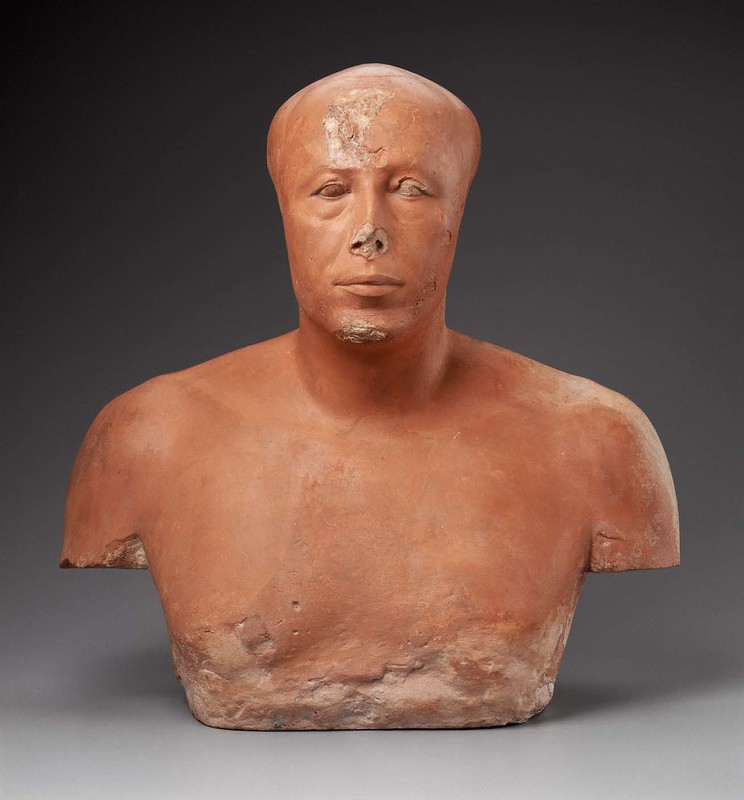Bust of Ankh-haf
Title
Bust of Ankh-haf
Date
Egyptian 4th Dynasty, Old Kingdom (ca. 2520-2494 BCE)
Artist or Workshop
Unknown
Materials
limestone base covered with plaster and painted red
Height of the work
50.48 cm tall
Provenience
Egypt, Giza, Western Cemetery, Mastaba of Ankh-haf, tomb G 7510
Current Location
Museum of Fine Arts in Boston, MA
Sitter Biography
Ankh-haf was an official in the 4th dynasty of Egypt. He is most likely the son of Sneferu, an Egyptian king. Ankh-haf served as an official for Khafre as an overseer of works such as the second pyramid at Giza and the carving of the Great Sphinx.
Description and Significance
Description:
The Bust of Ankh-haf is a statue made from limestone and plaster that has been painted red. The eyes have also been painted to give them a life-like quality. The realistic quality can also be seen from the rendering of the musculature on the should, chest, and back. It is of a man from the chest up with missing arms. The arms are broken because the statue was most likely part of a false door for offering at the Mastaba of Ankh-haf. The bust shows a more realistic and less idealized portrait of Ankh-haf because there are bags under his eyes, age lines in his face, and a receding hairline. There is damage to the nose, forehead, chin, and ears that were already present when the bust was found. It is believed that this damage was intentionally done to deface the spirit, or ka, of the statue. There are also scratches where the red coloring has come off on the back of the statue. One of the notable qualities of the bust is the bulb-shaped head.
Significance:
One of the important pieces of knowledge that this bust teaches scholars is the role of skin color in ancient Egypt. The Bust of Ankh-haf is painted red, however this is not an indication that he is of a particular race or ethnicity. The red coloring is an indication that this is a male figure. Typically men were depicted with red or brown tones and women were depicted with tan or yellow tones.
Another reason that this work is so significant is because of how life-like it is. There is very careful attention paid to the rendering of the face. Viewers can see the bags under the eyes and lines around the mouth and nose to show aging. The lips are also incredibly lifelike. The fact that it is so stylized shows that this is not a royal as royal figures during this time were shown in an idealized manor.
The Bust of Ankh-haf is a statue made from limestone and plaster that has been painted red. The eyes have also been painted to give them a life-like quality. The realistic quality can also be seen from the rendering of the musculature on the should, chest, and back. It is of a man from the chest up with missing arms. The arms are broken because the statue was most likely part of a false door for offering at the Mastaba of Ankh-haf. The bust shows a more realistic and less idealized portrait of Ankh-haf because there are bags under his eyes, age lines in his face, and a receding hairline. There is damage to the nose, forehead, chin, and ears that were already present when the bust was found. It is believed that this damage was intentionally done to deface the spirit, or ka, of the statue. There are also scratches where the red coloring has come off on the back of the statue. One of the notable qualities of the bust is the bulb-shaped head.
Significance:
One of the important pieces of knowledge that this bust teaches scholars is the role of skin color in ancient Egypt. The Bust of Ankh-haf is painted red, however this is not an indication that he is of a particular race or ethnicity. The red coloring is an indication that this is a male figure. Typically men were depicted with red or brown tones and women were depicted with tan or yellow tones.
Another reason that this work is so significant is because of how life-like it is. There is very careful attention paid to the rendering of the face. Viewers can see the bags under the eyes and lines around the mouth and nose to show aging. The lips are also incredibly lifelike. The fact that it is so stylized shows that this is not a royal as royal figures during this time were shown in an idealized manor.
References
Bolshakov, Andrey. ""What Did the Bust of Ankh-haf Originall Look Like?" Journal of the Museum of Fine Arts, Boston, vol 3, 1991, pp. 4-14.
Breckenridge, J. D. 1968, Likeness: A Conceptual History of Ancient Portraiture, Evanston. pp. 35-45. Print.
"Bust of Prince Ank-haf". Museum of Fine Arts Boston. mfa.org. Web. Accessed February 12, 2018.
Breckenridge, J. D. 1968, Likeness: A Conceptual History of Ancient Portraiture, Evanston. pp. 35-45. Print.
"Bust of Prince Ank-haf". Museum of Fine Arts Boston. mfa.org. Web. Accessed February 12, 2018.
Contributor
Nina Cardillo
Citation
Unknown, “Bust of Ankh-haf,” Digital Portrait "Basket" - ARTH488A - "Ancient Mediterranean Portraiture", accessed May 20, 2024, https://classicalchopped2.artinterp.org/omeka/items/show/5.
Item Relations
This item has no relations.

